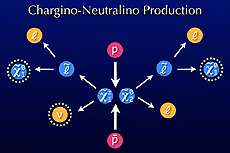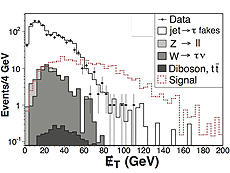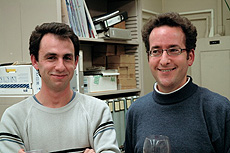Search for supersymmetry's John Hancock
 |
Production of the SUSY particles searched for in this analysis.
The red circles are the incoming proton and antiproton, the blue circles are the SUSY particles, and the gold circles are the leptons. From the three charged leptons we find a like-sign pair. The dashed circles show invisible particles.
|
As is the case in historical documents, in particle physics there are signatures, and then there are signatures. Physicists at the Tevatron and the Large Hadron Collider spend countless hours devising the perfect searches for exotic new particles. They then pore over the trillions of events collected by the gigantic experiments at these colliders looking for the telltale event characteristics, or signatures, that would indicate the discovery of a new fundamental particle.
Supersymmetry (SUSY to her friends) is an intriguing theory that has been at the top of the high-energy physics Most Wanted list for a few decades now. It boldly states that all the leptons, quarks, gauge bosons (such as the photon) and the Higgs account for merely half
of the true slate of fundamental particles of nature. Doubling the list would yield truly remarkable consequences. For starters, SUSY makes the Higgs more stable and provides a dark-matter particle.
Physicists at the Tevatron's CDF experiment have searched large data sets for SUSY using the John Hancock of signatures. They look for events with two leptons, where lepton refers to an electron, muon or tau. While many Standard Model (SM) processes yield dileptons, this search requires the leptons have like-sign electric charge. Thus, a positron and a positively charged tau (e+τ+) is okay, but a positron and a negatively charged tau (e+τ-) isn't. This requirement removes the lion's share of the SM backgrounds but would keep much of the SUSY signal. Thus, seeing a preponderance of like-sign events would be a clear indication something exciting was afoot, for example, the production of two SUSY particles, the chargino and neutralino (see top figure). Furthermore, this search adds the additional requirement that one of the leptons be a tau particle, as previous searches for SUSY from the Tevatron and LHC indicate that looking for the tau might be a crucial ingredient for success.
Unfortunately, a careful comparison between the data and the expectations from the SM and SUSY predictions indicates that Hancock is still at large (see bottom figure). For the time being, the Standard Model is safe! Nevertheless, particle physicists at the Tevatron, the LHC and beyond, will continue the hunt for new particles knowing that any discovery will teach us something fundamental about our universe.
—Maxwell Chertok
Learn more
 |
The invisible particles exit the detector with no interaction. This results in missing transverse energy, which is shown in this figure. The SUSY signal would give an enhancement at high values (shown in red), but the CDF data agree with the Standard Model prediction.
|
 |
Physicists Robert Forrest, now at Stanford, and Maxwell Chertok, University of California, Davis, were responsible for this analysis.
|
|